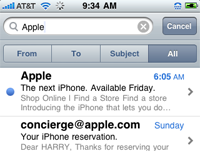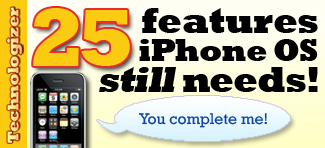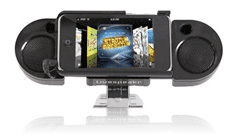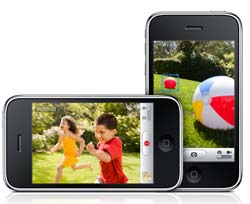 All iPhone all the time!
All iPhone all the time!
Josh Topolsky’s review at Engadget.
Gizmodo’s Jason Chen is enthusiastic.
Gizmodo reviews iPhone OS 3.0.
Nice walkthrough by Rene Ritchie.
 All iPhone all the time!
All iPhone all the time!
Josh Topolsky’s review at Engadget.
Gizmodo’s Jason Chen is enthusiastic.
Gizmodo reviews iPhone OS 3.0.
Nice walkthrough by Rene Ritchie.
 Finally, news involving AT&T and iPhones that won’t cause anyone to become violently angry! Faced with widespread grumbling by iPhone 3G owners who thought that they deserved to be able to upgrade to the iPhone 3G S for the same price as new customers, the company has rethought its pricing plan. Some customers–ones who spend more on service plans, apparently–will qualify to get the 3G S for the new-customer two-year-contract prices ($199 for 16GB, $299 for 32GB). That’s $200 less than the price AT&T had planned to charge, and $400 less than the unsubsidized, no-contract price.
Finally, news involving AT&T and iPhones that won’t cause anyone to become violently angry! Faced with widespread grumbling by iPhone 3G owners who thought that they deserved to be able to upgrade to the iPhone 3G S for the same price as new customers, the company has rethought its pricing plan. Some customers–ones who spend more on service plans, apparently–will qualify to get the 3G S for the new-customer two-year-contract prices ($199 for 16GB, $299 for 32GB). That’s $200 less than the price AT&T had planned to charge, and $400 less than the unsubsidized, no-contract price.
Those lucky customers are the ones who AT&T has been telling would qualify for the cheaper upgrade at any point prior to September 30th of this year. My eligibility date is July 12th; the AT&T site is still telling me I’ll have to pay $499 for a 32GB phone, but I’m assuming I’m good. I’m also assuming that I’ll get the lower price even though I plan to buy my 3G S at an Apple Store, not an AT&T shop. (I guess I’ll find out bright and early on Friday.)
No word yet on what AT&T will do for anyone who pre-ordered and paid for a phone already, but one hopes that they’ll simply rebate the $200 without having to be asked.
I’ve written that I didn’t think AT&T was obligated to offer the steepest discount to people who had already gotten a subsidized price on an iPhone 3G and were still under contract. But it’s a classy move on its part to do so–and a smart one. After a week and a half of some of the most intense negative coverage I can remember for a tech company, it just did something that will tickle some of its most loyal customers. Especially those who’d already decided to pay the higher price and will now end up with $200 back in their pockets.
I said that this news wouldn’t upset anyone, but I could be wrong–does anyone want to contend that every iPhone 3G owner should qualify for the full price break? (I’m glad that my upgrade qualification date wasn’t October 1st…)
 As promised, Apple has released iPhone OS 3.0. I’ve been using the gold master version for a week, and it’s been a joy so far.
As promised, Apple has released iPhone OS 3.0. I’ve been using the gold master version for a week, and it’s been a joy so far.
Apple’s approach to the the iPhone’s development still makes me think of Benjamin Button: The OS was dazzling from the start, but only Apple intentionally put off implementing some of the mundane, basic stuff that you would have assumed every phone OS would have. With 3.0, it’s mostly there. (Which hasn’t stopped me from starting to compile a wish list of new features.)
iPhone 2.0 was about one sea change of a new feature: third-party apps. 3.0, by contrast, sports no one signature improvement. It really is about improvement everywhere. (Here’s an excellent point-by-point account of the hundred new features.)
 For me, the single most meaningful new feature so far, by far, is search–especially within e-mail, where it’s beautifully done and makes the e-mail app far more useful. (I had stopped using the iPhone Mail in favor of Gmail; now I’ve switched back.) The far more widespread support for landscape-mode use of applications is a close second. Apple also says that Safari is faster, and while I haven’t done any benchmarks, the browser does indeed feel much snappier.
For me, the single most meaningful new feature so far, by far, is search–especially within e-mail, where it’s beautifully done and makes the e-mail app far more useful. (I had stopped using the iPhone Mail in favor of Gmail; now I’ve switched back.) The far more widespread support for landscape-mode use of applications is a close second. Apple also says that Safari is faster, and while I haven’t done any benchmarks, the browser does indeed feel much snappier.
 It’s also fun to burrow around the OS and encounter minor-but-welcome tweaks all over the place, like the way the camera app now shows a thumbnail link to the last photo you snapped. And if AT&T ever permits tethering–and offers a network that doesn’t lapse into EDGE at the worst moments–I’ll be thrilled.
It’s also fun to burrow around the OS and encounter minor-but-welcome tweaks all over the place, like the way the camera app now shows a thumbnail link to the last photo you snapped. And if AT&T ever permits tethering–and offers a network that doesn’t lapse into EDGE at the worst moments–I’ll be thrilled.
 Oh, and in case you hadn’t heard, iPhones now let you cut, copy, and paste. I wasn’t irate when the OS didn’t have this feature, and haven’t needed it so far. But it’s there, and it works well.
Oh, and in case you hadn’t heard, iPhones now let you cut, copy, and paste. I wasn’t irate when the OS didn’t have this feature, and haven’t needed it so far. But it’s there, and it works well.
Much of what’s interesting about OS 3.0 will only reveal itself as new third-party applications come out: notifications, in-store purchasing, peer-to-peer connectivity, http video streaming, better GPS and map support, peripheral connectivity through the dock connector, and more. They’ll only live up to their potential if they’re widely embraced by developers. But everything we know about the iPhone as an app platform suggests that there’s every reason to be optimistic.
When Apple released iPhone 2.0 last July, there was widespread griping that it was buggy and unstable. Two months late, Apple polished the OS up with the much smoother OS 2.1. I can only speak about m y own personal experience with iPhone OS 3.0 to date, and sample sizes of one aren’t statistically significant. But it hasn’t crashed on me, and has actually made my iPhone more reliable: Until now, my phone’s Internet connection has had a nasty habit of stalling until I did a reboot, and–as far as I can tell–OS 3.0 has eliminated this major headache.
On Friday, some owners of iPhone 3Gs will spend hundreds of dollars to upgrade to the not-radically-different iPhone 3G S–in some cases grumbling as they do so. iPhone 3.0 brings most of what’s cool about the 3G S to any iPhone–for free. (For iPod Touch owners, it costs $10, and is merely a steal.) To riff on an old Apple OS X upgrade slogan, it’s like a new iPhone for your iPhone.
Once you’ve checked it out, let us know what you think.
 The 3.0 software will bring an exciting new feature to those iPhone and iPod touch users who have forked $9.99 over for the MLB application: live games. The first games would be streamed Thursday at 2:20pm (Chicago Cubs-White Sox) and 8:15pm (Detroit Tigers-St. Louis Cardinals). While initially only two games a day would be streamed, MLB hopes to expand it to the entire slate.
The 3.0 software will bring an exciting new feature to those iPhone and iPod touch users who have forked $9.99 over for the MLB application: live games. The first games would be streamed Thursday at 2:20pm (Chicago Cubs-White Sox) and 8:15pm (Detroit Tigers-St. Louis Cardinals). While initially only two games a day would be streamed, MLB hopes to expand it to the entire slate.
It should be noted that live video would be limited to out-of-market games. That means for me here in Reading, PA, I wouldn’t be able to watch Phillies games (after last night’s 8-3 embarrassment against the Blue Jays, I don’t know if I care, heh). However, its a giant step forward for streaming video on the iPhone.
The service will work whether the user is on 3G or Wi-Fi: the MLB servers will adjust the speed accordingly to ensure proper playback. Its going to be interesting to see whether 3G streaming works well at all considering AT&T’s increasing network problems.
 I think of TweetDeck as the SUV of Twitter clients–it’s really powerful, but also resource-hungry, and it takes up a lot of (screen) space. Squeezing it down to fit on an iPhone kind of sounded like putting Guernica on a postage stamp. But the iPhone version of the app, which arrived in the iTunes App Store late on Tuesday, retains the desktop version’s personality, and a surprising percentage of its power. It also seems to be unstable–or at least it’s stalled on me, and Twitter is rife with reports of other crashy behavior. I can’t give it an enthusiastic and unqualified thumbs up until until it seems to be running reliably for most folks, but I’m basically impressed with the approach the TweetDeck folks took in bringing their free application to the iPhone.
I think of TweetDeck as the SUV of Twitter clients–it’s really powerful, but also resource-hungry, and it takes up a lot of (screen) space. Squeezing it down to fit on an iPhone kind of sounded like putting Guernica on a postage stamp. But the iPhone version of the app, which arrived in the iTunes App Store late on Tuesday, retains the desktop version’s personality, and a surprising percentage of its power. It also seems to be unstable–or at least it’s stalled on me, and Twitter is rife with reports of other crashy behavior. I can’t give it an enthusiastic and unqualified thumbs up until until it seems to be running reliably for most folks, but I’m basically impressed with the approach the TweetDeck folks took in bringing their free application to the iPhone.
On the desktop, TweetDeck’s signature features are the way it lets you create groups of tweeters, and the columns that show incoming tweets, direct messages @mentions, search results, and more. They’re both there in the iPhone edition, and while you can only see one column at a time, it’s a cinch to slip-slide between all the ones you’ve created. The cool thing about group support is that a new version of the TweetDeck desktop client, also just released, enables seamless syncing of your groups among all your computers and your iPhone. (The new desktop client offers a bunch of other new features, including support for multiple accounts.) When I’m king, every desktop app will sync every setting between every copy you use–but for some reason almost none do it just yet. (One that comes to mind that does: Opera, with its Opera Link feature.) I confess to not using TweetDeck much on my Mac and Windows machines, but group syncing among multiple clients has me enthusiastic about giving it a try again.
The iPhone client sports most of the obligatory features you expect in an iPhone Twitter client: built-in URL shortening, GPS and maps, photos, and a bunch of ways to surf between tweets and tweeters and see what’s up. Like its desktop big brother, it also pops up little status messages notifying you about incoming tweets, @mentions, and direct messages. They appear only within TweetDeck itself–in theory, I guess the new iPhone 3.0 Notifications feature could be used to display them when you’re in other applications, but they’d probably drive you crazy pretty instantly. But if the day comes when Apple will let apps run in the background, TweetDeck would be an excellent candidate–it would feel even more like the desktop version if it could sit there and pull in tweets, letting you quickly check them whenever you have a spare moment.
iPhone users have an embarassment of Twitter riches to choose from: Tweetie, TwitterFon, Twitterific, Twinkle, and more. A TweetDeck that didn’t crash would be a formidable competitor, especially since it’s both free and ad-free. Let’s hope an update comes along shortly. After the jump, some images of this good-looking, potent piece of software.

So it’s no knock on version 3.0 of the iPhone software to say that even though it contains 100 new features–some of which are a big deal–there are plenty more it could benefit from. What follows is a highly personal list of stuff I think this OS needs–and as far as I know, none of it is in OS 3.0. If we see some of it in OS 3.1, and more in 4.0, and a sizable chunk by 5.0, I’ll be a contented man.
I said the list is personal, but I tried to be realistic. It contains nothing that I can’t see Apple enabling, or which would require new hardware. I also didn’t include multitasking or Flash support on this list. They’ve been covered to death, and my gut tells me neither is coming to the iPhone soon. Consider them features #26 and #27 if you like, though–and I do suggest some things that might lessen the need for them.
Ready to celebrate the release of OS 3.0 (which is due later today) by being dissatisfied, nitpicky, and generally unreasonable? Here we go.
![]() A year into the era of third-party iPhone software, there may be 50,000 applications for Apple’s phone. But nobody needs that many, of course–hey, they’d be a tight squeeze even if you’ve got a 32GB iPhone 3G S. What you want are…the applications you want. One of the ones I want is a solid, simple Microsoft Office-compatible suite for my iPhone. And I’m still waiting for one that’s everything an iPhone suite should be.
A year into the era of third-party iPhone software, there may be 50,000 applications for Apple’s phone. But nobody needs that many, of course–hey, they’d be a tight squeeze even if you’ve got a 32GB iPhone 3G S. What you want are…the applications you want. One of the ones I want is a solid, simple Microsoft Office-compatible suite for my iPhone. And I’m still waiting for one that’s everything an iPhone suite should be.
Last year, things looked promising: The two major makers of mobile suites, Dataviz and Quickoffice, both announced plans to support the iPhone. Quickoffice got there first, but did so in drips and drabs: First, it released a version that only had a spreadsheet and some file management tools. Then it added a word processor that lacked core features such as autocorrection. Then it finally came out with an update that’s pretty good, but is still hobbled by the fact that there’s no way for it to get at file attachments in the phone’s e-mail application, since Apple don’t permit it. (Instead, you can shuttle documents back and forth via MobileMe or Wi-Fi.)
 Yesterday, DataViz announced that its Documents to Go suite was live on the iPhone App Store. And once again, it turns out that it’s less of a suite and more of a work in progress. The current version is a word processor that’s slicker than Quickoffice’s, with two-way file synchronization and optional support for Exchange attachments. But there’s no spreadsheet. DataViz says that people who buy Docs to Go now at discounted prices ($5 without Exchange support, $10 with) will get the spreadsheet for free later.
Yesterday, DataViz announced that its Documents to Go suite was live on the iPhone App Store. And once again, it turns out that it’s less of a suite and more of a work in progress. The current version is a word processor that’s slicker than Quickoffice’s, with two-way file synchronization and optional support for Exchange attachments. But there’s no spreadsheet. DataViz says that people who buy Docs to Go now at discounted prices ($5 without Exchange support, $10 with) will get the spreadsheet for free later.
I’m not sure why it’s taken both companies so long to get their venerable, well-done packages onto the iPhone, other than that building a capable productivity suite that’s compatible with Microsoft Office is a larger challenge than designing even an admirable Twitter client. (Let’s not even discuss fart apps.) I also worry that the pressure on iPhone developers to release apps at the cheapest possible price makes it hard for them to justify investing immense resources in building ambitious stuff: Docs to Go for iPhone may start at five bucks, but the highest-end version of its Palm-based ancestor goes for $90. But maybe suite companies will end up selling enough iPhone products in such high volume that it’ll work out.
Long-term, I remain optimistic: Quickoffice has already made a lot of progress, and a few minutes with Documents to Go’s word processor will tell you that DataViz hasn’t been slacking–it’s just been making sure that what it releases is really good. I also think that Apple will eventually give apps like these the hooks into the OS they need to be integrated with e-mail and other iPhone apps. For now, though, I’m still waiting for iPhone suites to give me everything that came standard on my Psion Series 3 palmtop fifteen years ago.
 There’s a surging sea of portable speakers out there for iPods, but ones designed to work well with iPhones are a rarer breed. Which is why I’m impressed with DGA’s Livespeakr, a collapsible, battery-powered speaker setup that was designed with the iPhone in mind and which delivers very good sound quality considering its cost ($99 list in black or white versions; $85 at the Livespeakr site) and size.
There’s a surging sea of portable speakers out there for iPods, but ones designed to work well with iPhones are a rarer breed. Which is why I’m impressed with DGA’s Livespeakr, a collapsible, battery-powered speaker setup that was designed with the iPhone in mind and which delivers very good sound quality considering its cost ($99 list in black or white versions; $85 at the Livespeakr site) and size.
 I’m not saying it’s a good idea to try and buy an iPhone 3G S on next Friday, the day the phone is released. For one thing, the single best thing about the phone is likely to be iPhone OS 3.0, which every iPhone owner will be able to snag as a free download two days before that. For another, many iPhone 3G owners will qualify for larger discounts on the 3G S if they wait a month or two before upgrading.
I’m not saying it’s a good idea to try and buy an iPhone 3G S on next Friday, the day the phone is released. For one thing, the single best thing about the phone is likely to be iPhone OS 3.0, which every iPhone owner will be able to snag as a free download two days before that. For another, many iPhone 3G owners will qualify for larger discounts on the 3G S if they wait a month or two before upgrading.
But what if you absolutely must have a 3G S on the day of launch–and not only on the day of launch, but as early as possible on that day? (Hey, maybe you’re a tech journalist who wants to write about it while it’s still hot, hot, hot.) You’ve got multiple options, and they all have theoretical virtues and potential pitfalls?
Preordering from Apple for shipment. Apple says that iPhone 3G Ss will arrive on June 19th, the day of the phone’s release. It doesn’t say when on that day to expect them, though. And given that shipping is free, I’m thinking that they’re going out by some method that’s cheaper than priority overnight and therefore they may show up in the afternoon.
Preordering from Apple for in-store pickup. I did this at my local Apple Store, and it was kinda confusing–I used a Web-based signup form, and it never asked me for my name or gave me confirmation that I was all set. And it mysteriously talked about me buying a last-generation iPhone 3G even after I specified that I wanted a 32GB white iPhone 3G S. Given that I have no proof that I preordered, I have these visions of showing up and being turned away. In any event, the Apple Store rep I talked to told me that the store would open at 8am, and that both those who preordered and those who didn’t must wait in the same line. That likely means that it’ll make sense to show up really early. 5am, perhaps? No, 4am sounds safer.
Preordering from AT&T for shipment. The AT&T site seems to be dedicated to the notion that every piece of information must be phrases in a way that’s slightly too vague to be useful. Here’s what it says about shipping schedules:
Pre-orders for iPhone 3G S will be shipped with overnight priority and will be processed to arrive as early as June 19, 2009, if submitted by 12 p.m. noon C.T., June 17, 2009.
You might assume that “shipped with overnight priority” means that the phones will be shipped via priority overnight, and will arrive in the morning. But I’m guessing that AT&T really means that it’ll give priority to getting these phones out for arrival the next day. In any event, it’s very clear that it makes no guarantee that they’ll arrive by June 19th. I’m not sure whether that’s because it’s less confident about supplying demand than Apple is, or whether it’s simply covering itself by promising nothing.
Preordering from AT&T at a local store. AT&T stores are opening at 7am on the 19th–an hour before Apple Stores–and only for folks who preordered. Which makes preordering for local pickup from an AT&T outlet sound like the most efficient wayt to get a 3G S early. But when I tried to order one at my local AT&T shop, the rep told me that I might not get my phone until the 20th.
Thinking all this over makes my brain hurt. But here are some apparent facts:
Given all that, if I were trying to be among the very first people to buy an iPhone 3G S, I’d preorder from an Apple Store and wake up at the crack of dawn on Friday. I’m not saying I’m going to do this. But if I do, you’ll be the first to know…
 Lots of little Microsoft stories:
Lots of little Microsoft stories:
Free anti-virus from Microsoft.
Microsoft kills off Money completely.
Smartphone total cost of ownership.
